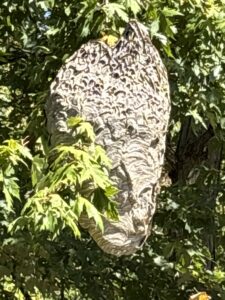Carpenter Bee Control Services

What Are Carpenter Bees?
(Xylocopa species)
Carpenter bees are large, robust bees that closely resemble bumblebees but have distinct differences. These solitary bees get their name from their habit of boring into wood to create nests for their young.
Key Characteristics:
Unlike bumblebees, carpenter bees have a shiny, hairless black abdomen that appears almost metallic. The males are often seen hovering aggressively near nest sites but cannot sting, while females can sting but rarely do unless directly handled.
Signs of Carpenter Bee Activity
Carpenter Bee Tunnels
What to Look For:
- Round holes: Perfect 1/2-inch diameter holes in wood surfaces
- Yellow staining: Sawdust and bee excrement below holes
- Buzzing sounds: Loud hovering near wooden structures
- Wood shavings: Small piles of sawdust beneath entry holes
- Tunnels: Galleries that run perpendicular to the surface
⚠️ Structural Damage Concerns
While individual carpenter bees cause minimal damage, repeated infestations over multiple years can weaken wooden structures. The tunnels they create can attract woodpeckers, which cause additional damage while searching for bee larvae.
Why Carpenter Bees Are Problematic
Property Damage:
- Tunnels weaken wooden structures over time
- Unsightly holes in decks, siding, and trim
- Staining from bee waste products
- Secondary damage from woodpeckers
Preferred Nesting Sites:
- Deck railings and support beams
- House siding and trim
- Fence posts and pergolas
- Outdoor furniture
- Play sets and swing sets
Lifecycle & Behavior:
Carpenter bees overwinter as adults and emerge in spring to mate. Females excavate tunnels 6-8 inches deep, where they lay eggs and provision cells with pollen. The new generation emerges in late summer, and the cycle repeats.
Our Treatment Approach
🛡️ Comprehensive Carpenter Bee Control
Our professional treatment program addresses both active infestations and prevents future problems through targeted application and preventive measures.
Treatment Process:
- Inspection: Thorough assessment of property and identification of active tunnels
- Direct Treatment: Application of residual insecticides into active galleries
- Surface Treatment: Protective barrier application to vulnerable wood surfaces
- Tunnel Sealing: Sealing of holes after treatment (when appropriate)
- Follow-up: Monitoring and additional treatments as needed
Treatment Timing:
The most effective treatment occurs in early spring (April-May) when adults are active but before new tunnels are established, and again in late summer when new adults emerge.
Prevention Strategies:
- Regular application of wood stains or paints
- Installation of hardware cloth over vulnerable areas
- Prompt repair of existing holes
- Use of naturally resistant wood species for new construction
